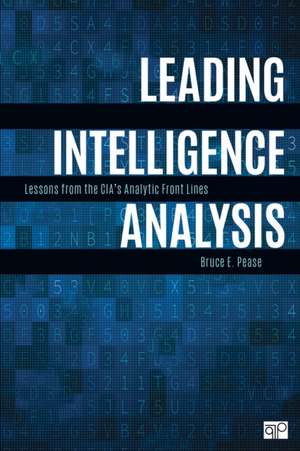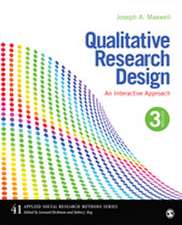Leading Intelligence Analysis: Lessons from the CIA’s Analytic Front Lines
Autor Bruce E. Peaseen Limba Engleză Paperback – 7 feb 2019
Preț: 391.65 lei
Preț vechi: 502.11 lei
-22% Nou
Puncte Express: 587
Preț estimativ în valută:
74.94€ • 78.46$ • 62.01£
74.94€ • 78.46$ • 62.01£
Carte disponibilă
Livrare economică 15-29 martie
Livrare express 01-07 martie pentru 24.18 lei
Preluare comenzi: 021 569.72.76
Specificații
ISBN-13: 9781506397139
ISBN-10: 1506397131
Pagini: 256
Dimensiuni: 152 x 229 x 17 mm
Greutate: 0.3 kg
Ediția:First Edition
Editura: SAGE Publications
Colecția CQ Press
Locul publicării:Washington DC, United States
ISBN-10: 1506397131
Pagini: 256
Dimensiuni: 152 x 229 x 17 mm
Greutate: 0.3 kg
Ediția:First Edition
Editura: SAGE Publications
Colecția CQ Press
Locul publicării:Washington DC, United States
Recenzii
“Bruce Pease has written a much needed book on a long ignored topic: how does one lead analysts? Most analysis is, at some level a group activity, whether in government or the private sector. Much has been written about good vs. bad analysis and how to train analysts, but Pease, himself a veteran senior CIA analyst and manger, focuses on what the managers and leaders of these analysts need to know and should be thinking about. Leadership matters in analysis as in all other endeavors and Pease offers invaluable guidance on how best to do this. This book is a must for anyone in a leadership role in an analytic enterprise.”
“While Director of CIA, I sometimes described the analytic workforce there as resembling a tenured college faculty as I worked to preserve the excellence and independence of thought so essential to success (in either body) while harnessing those energies to a common, disciplined enterprise. Bruce Pease was my guide and counselor for that effort and now Bruce has captured his advice and wisdom in Leading Intelligence Analysis, a must read for any senior in or out of government who leads—or depends on—analysis.”
"A very thoughtful book by a very thoughtful and respected professional. But this book goes way beyond thoughtful. It is exciting — the topics are hard to resist. And it is practical, putting powerful ideas into context. The lessons carry beyond intelligence analysis — they hit home for corporate leaders struggling to make forecasts despite ambiguity, complexity and deception."
“Bruce Pease is one of the finest leaders and analysts to ever serve at the Central Intelligence Agency. Few had his ability to cut through complicated issues and provide senior leaders with wisdom. No matter what business you are in, Bruce brings clarity and balance to help get the most out of your forecasters, inundated with data in this digital age. The results will be game changing.”
“While Director of CIA, I sometimes described the analytic workforce there as resembling a tenured college faculty as I worked to preserve the excellence and independence of thought so essential to success (in either body) while harnessing those energies to a common, disciplined enterprise. Bruce Pease was my guide and counselor for that effort and now Bruce has captured his advice and wisdom in Leading Intelligence Analysis, a must read for any senior in or out of government who leads—or depends on—analysis.”
"A very thoughtful book by a very thoughtful and respected professional. But this book goes way beyond thoughtful. It is exciting — the topics are hard to resist. And it is practical, putting powerful ideas into context. The lessons carry beyond intelligence analysis — they hit home for corporate leaders struggling to make forecasts despite ambiguity, complexity and deception."
“Bruce Pease is one of the finest leaders and analysts to ever serve at the Central Intelligence Agency. Few had his ability to cut through complicated issues and provide senior leaders with wisdom. No matter what business you are in, Bruce brings clarity and balance to help get the most out of your forecasters, inundated with data in this digital age. The results will be game changing.”
Cuprins
Foreword
Acknowledgments
About the Author
Chapter 1: Leading Analysis is Different from Doing Analysis
The Leader of Analysis or the Uberanalyst
Which Substantive Analyst Responsibilities Carry Over?
No Lazy Thinking
Setting Standards for the First Time
Analyze Everything
Chapter 2: Understanding Analysts
Some Classic Traps
Ten Things Analysts Hate
Chapter 3: Shaping the Environment
Nurturing Trust is Job 1
Taking the Pulse
Seven Critical Balances
Stress in the Environment
Chapter 4: Choosing the Best Approach and Techniques
Evolving Approaches: Three Paradigms
Picking your paradigm
Blending Approaches
The Expanding Menu of Analytic Techniques
Keep Your Eye Out for New Choices
Chapter 5: Nurturing the New Idea: Creativity, Insight, and Innovation in Analysis
Creative Analysis?
Stifling Creativity and Innovation in Analysis
And What of Insight?
Promoting Creativity, Innovation, and Insight
Chapter 6: Asking the Right Question
Toxic Questioning
The Right Question
The Wrong Question
Chapter 7: The Hardest Question: What Is Going to Happen? Prediction and Warning in Analysis
Analyzing Predictability
When History Pivots
Humility, an Open Mind, and Practice Required
Prediction is Always a Gamble
Prediction is the Leader’s Responsibility
What’s the Worst that Could Happen? Leading Warning
What Is Reasonable in an Unreasonable World?
Chapter 8: Ethics in Analysis
What am I doing in this business?
Leading a Dialogue on Values
Climbing Down off the Analyst’s High Horse
Driving Collection
Resisting Politicization
Are We Responsible for Consequences?
Impact of Covert Action
In Closing
Chapter 9: Analysis as a Business
The Business Part of the Business
Ensuring Brand Loyalty (Getting Your Customers Hooked on Your Service)
Prioritize Your Customers
Tend Your Organization’s Reputation with the Front Office
Align Your Enterprise
Business Is Too Good—I’m Swamped!
Change is Reality
It Doesn’t Take an MBA
Chapter 10: The Tools of Twenty-First-Century Analysis
Judging Tools For Analysis
First- and Second-Level IT Tools to Help All Analysts
Third-level Tools: Big Data, Data Science, and Predictive Analytics
Two Keys: Volume and Repetition
The Dreaded—but Inevitable—Black Box
The Analyst Is Not About to be Replaced
Chapter 11: Analysis at the Speed of Information
Get Your Mind Right and Theirs
Build an Information Strategy
Can we analyze faster?
Nurture Your Inner Opportunist
Afterword
Bibliography
Index
Acknowledgments
About the Author
Chapter 1: Leading Analysis is Different from Doing Analysis
The Leader of Analysis or the Uberanalyst
Which Substantive Analyst Responsibilities Carry Over?
No Lazy Thinking
Setting Standards for the First Time
Analyze Everything
Chapter 2: Understanding Analysts
Some Classic Traps
Ten Things Analysts Hate
Chapter 3: Shaping the Environment
Nurturing Trust is Job 1
Taking the Pulse
Seven Critical Balances
Stress in the Environment
Chapter 4: Choosing the Best Approach and Techniques
Evolving Approaches: Three Paradigms
Picking your paradigm
Blending Approaches
The Expanding Menu of Analytic Techniques
Keep Your Eye Out for New Choices
Chapter 5: Nurturing the New Idea: Creativity, Insight, and Innovation in Analysis
Creative Analysis?
Stifling Creativity and Innovation in Analysis
And What of Insight?
Promoting Creativity, Innovation, and Insight
Chapter 6: Asking the Right Question
Toxic Questioning
The Right Question
The Wrong Question
Chapter 7: The Hardest Question: What Is Going to Happen? Prediction and Warning in Analysis
Analyzing Predictability
When History Pivots
Humility, an Open Mind, and Practice Required
Prediction is Always a Gamble
Prediction is the Leader’s Responsibility
What’s the Worst that Could Happen? Leading Warning
What Is Reasonable in an Unreasonable World?
Chapter 8: Ethics in Analysis
What am I doing in this business?
Leading a Dialogue on Values
Climbing Down off the Analyst’s High Horse
Driving Collection
Resisting Politicization
Are We Responsible for Consequences?
Impact of Covert Action
In Closing
Chapter 9: Analysis as a Business
The Business Part of the Business
Ensuring Brand Loyalty (Getting Your Customers Hooked on Your Service)
Prioritize Your Customers
Tend Your Organization’s Reputation with the Front Office
Align Your Enterprise
Business Is Too Good—I’m Swamped!
Change is Reality
It Doesn’t Take an MBA
Chapter 10: The Tools of Twenty-First-Century Analysis
Judging Tools For Analysis
First- and Second-Level IT Tools to Help All Analysts
Third-level Tools: Big Data, Data Science, and Predictive Analytics
Two Keys: Volume and Repetition
The Dreaded—but Inevitable—Black Box
The Analyst Is Not About to be Replaced
Chapter 11: Analysis at the Speed of Information
Get Your Mind Right and Theirs
Build an Information Strategy
Can we analyze faster?
Nurture Your Inner Opportunist
Afterword
Bibliography
Index
Notă biografică
Descriere
Written by an experienced professional who has led Navy Intelligence and CIA analysts in high-stakes situations, Leading Intelligence Analysis: Lessons from the CIA’s Analytic Front Lines introduces the fundamental managerial skills and practical tools needed to lead analysis projects conducted by individuals and teams. Author Bruce Pease provides insights into key questions such as What kind of environment draws out a team’s best work? What brings out their creativity? When does pressure bring out their best insights? When does pressure sap their intellectual energy? and What kind of team builds new knowledge rather than engaging in group-think?
This book draws on the author’s perspective from decades of leading intelligence analysts on critical issues, including war in the Middle East, terrorism after 9/11, and nuclear threats.
This book draws on the author’s perspective from decades of leading intelligence analysts on critical issues, including war in the Middle East, terrorism after 9/11, and nuclear threats.














